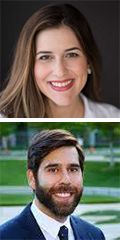The COVID-19 pandemic shook up our education system for ophthalmology and highlighted vulnerabilities in our learning, and training had to quickly evolve to continue providing high educational standards for residents and fellows.
Both of us work at safety-net hospitals where much of the academic teaching to residents and fellows is done, and we quickly adapted our traditional way of teaching ophthalmology (in-person lectures and clinical rotations) to a completely remote, virtual format.
Commiserating with academic colleagues from around the world about these abrupt changes, Dr. Ventura realized that this presented an opportunity to investigate how teaching centers from around the world were coping with these challenges.
Dr. Ventura and her colleagues designed an online survey for ophthalmology educators and 321 ophthalmologists from six continents replied. She evaluated the implementation of tele-education (e-learning) in ophthalmology during the COVID-19 pandemic and found a statistically significant increase in the use of all e-learning alternatives (web-based lectures, virtual meetings, live streaming video conferences, and e-class platforms) during the pandemic compared with traditional training.
In contrast, the surgical training of residents/fellows dropped dramatically during COVID-19, which affected the participants' perception of the quality of teaching. These findings show that although users are open-minded and interested in this new route, e-learning still poses challenges.
Is COVID-19 the catalyst that we need to make ophthalmology education completely remote?
COVID-19 has certainly propelled e-learning to the forefront of ophthalmology training in low-, middle- and high-income countries alike. However, demand for e-learning existed before COVID-19 due to its potential for global education in ophthalmology. Organizations like Orbis have been leading the charge for e-learning for almost a decade.
“We are at a critical crossroad right now. Hardware and software technology advancements are allowing us to democratize education,” Orbis Vice President of Clinical Services D. Hunter Cherwek, MD, said.
Orbis is the first organization to implement a process called “machine mentoring” using its Cybersight platform. This novel software allows ophthalmologists in low- and middle-income countries to take photos of unknown pathology and have artificial intelligence evaluate the media, suggest a diagnosis and annotate the image to justify its observations.
Additionally, a human mentor on Cybersight responds to requests for consultation within 24 hours using its network of volunteer expert ophthalmologists. Cybersight is also loaded with self-paced online courses and live and recorded lectures and surgical demonstrations that are geared towards the learning ophthalmologist, including 4K and 3D video content. Orbis is also working on a machine-learning model that suggests relevant e-learning content from its vast library based on the contents of a consultation case.
Lastly, Orbis has delved into remote skills-based training, using its platform to provide remote wet lab instruction using uploaded video assignments and live remote mentoring of real surgical cases. No wonder Cybersight has garnered over 30,000 registered users and continues to grow each day.
Our call to action for YOs everywhere is this: What will ophthalmology education look like in 20 years? How can medical ophthalmology education be done completely remotely? What about surgical ophthalmology education? What technology can we use now to get us there (augmented reality, virtual reality, 4K video streaming), and what technology do we need that might not exist yet?
Get futuristic! How would you design your exam room if you had to learn from mentors who wouldn’t be able to enter the exam room with you? We need YOs to spin the gears inside their head to come up with creative solutions to this problem.
Continue the conversation on social media: Tweet to @aao_ophth or post your ideas on the Academy’s Facebook page.
 |
About the authors: Camila V. Ventura, MD, PhD, is a member of the YO International subcommittee. She is a retina specialist in Brazil, as well as the YO Committee co-chair for the Pan American Association of Ophthalmology (PAAO).
Cristos Ifantides, MD, MBA, is also a member of the YO International Subcommittee. He specializes in cataract and anterior segment at the University of Colorado where he is Assistant professor of ophthalmology and director of the Ophthalmic Global Outreach Program. |